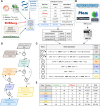A systematic approach to classify and characterize genomic islands driven by conjugative mobility using protein signatures
- PMID: 37526274
- PMCID: PMC10484663
- DOI: 10.1093/nar/gkad644
A systematic approach to classify and characterize genomic islands driven by conjugative mobility using protein signatures
Abstract
Genomic islands (GIs) play a crucial role in the spread of antibiotic resistance, virulence factors and antiviral defense systems in a broad range of bacterial species. However, the characterization and classification of GIs are challenging due to their relatively small size and considerable genetic diversity. Predicting their intercellular mobility is of utmost importance in the context of the emerging crisis of multidrug resistance. Here, we propose a large-scale classification method to categorize GIs according to their mobility profile and, subsequently, analyze their gene cargo. We based our classification decision scheme on a collection of mobility protein motif definitions available in publicly accessible databases. Our results show that the size distribution of GI classes correlates with their respective structure and complexity. Self-transmissible GIs are usually the largest, except in Bacillota and Actinomycetota, accumulate antibiotic and phage resistance genes, and favour the use of a tyrosine recombinase to insert into a host's replicon. Non-mobilizable GIs tend to use a DDE transposase instead. Finally, although tRNA genes are more frequently targeted as insertion sites by GIs encoding a tyrosine recombinase, most GIs insert in a protein-encoding gene. This study is a stepping stone toward a better characterization of mobile GIs in bacterial genomes and their mechanism of mobility.
© The Author(s) 2023. Published by Oxford University Press on behalf of Nucleic Acids Research.
Figures







Similar articles
-
Antibiotic Resistance in Vibrio cholerae: Mechanistic Insights from IncC Plasmid-Mediated Dissemination of a Novel Family of Genomic Islands Inserted at trmE.mSphere. 2020 Aug 26;5(4):e00748-20. doi: 10.1128/mSphere.00748-20. mSphere. 2020. PMID: 32848007 Free PMC article.
-
Patterns and architecture of genomic islands in marine bacteria.BMC Genomics. 2012 Jul 29;13:347. doi: 10.1186/1471-2164-13-347. BMC Genomics. 2012. PMID: 22839777 Free PMC article.
-
The association of virulence factors with genomic islands.PLoS One. 2009 Dec 1;4(12):e8094. doi: 10.1371/journal.pone.0008094. PLoS One. 2009. PMID: 19956607 Free PMC article.
-
Identification and characterization of pathogenicity and other genomic islands using base composition analyses.Future Microbiol. 2006 Oct;1(3):309-16. doi: 10.2217/17460913.1.3.309. Future Microbiol. 2006. PMID: 17661643 Review.
-
Conjugative and mobilizable genomic islands in bacteria: evolution and diversity.FEMS Microbiol Rev. 2014 Jul;38(4):720-60. doi: 10.1111/1574-6976.12058. Epub 2014 Jan 27. FEMS Microbiol Rev. 2014. PMID: 24372381 Review.
Cited by
-
Interactions and evolutionary relationships among bacterial mobile genetic elements.Nat Rev Microbiol. 2025 Jul;23(7):423-438. doi: 10.1038/s41579-025-01157-y. Epub 2025 Mar 11. Nat Rev Microbiol. 2025. PMID: 40069292 Review.
-
ICEberg 3.0: functional categorization and analysis of the integrative and conjugative elements in bacteria.Nucleic Acids Res. 2024 Jan 5;52(D1):D732-D737. doi: 10.1093/nar/gkad935. Nucleic Acids Res. 2024. PMID: 37870467 Free PMC article.
-
Is ICE hot? A genomic comparative study reveals integrative and conjugative elements as "hot" vectors for the dissemination of antibiotic resistance genes.mSystems. 2023 Dec 21;8(6):e0017823. doi: 10.1128/msystems.00178-23. Epub 2023 Nov 30. mSystems. 2023. PMID: 38032189 Free PMC article.
-
Extracellular Vesicles From Xylella fastidiosa Carry sRNAs and Genomic Islands, Suggesting Roles in Recipient Cells.J Extracell Vesicles. 2025 Jun;14(6):e70102. doi: 10.1002/jev2.70102. J Extracell Vesicles. 2025. PMID: 40560800 Free PMC article.
-
The LAMP-CRISPR-Cas13a technique for detecting the CBASS mechanism of phage resistance in bacteria.Front Microbiol. 2025 Mar 24;16:1550534. doi: 10.3389/fmicb.2025.1550534. eCollection 2025. Front Microbiol. 2025. PMID: 40196034 Free PMC article.
References
-
- Frost L.S., Leplae R., Summers A.O., Toussaint A.. Mobile genetic elements: the agents of open source evolution. Nat. Rev. Micro. 2005; 3:722–732. - PubMed
-
- Hentschel U., Hacker J.. Pathogenicity islands: the tip of the iceberg. Microbes Infect. 2001; 3:545–548. - PubMed
-
- Bellanger X., Bellanger X., Payot S., Leblond-Bourget N., Guédon G.. Conjugative and mobilizable genomic islands in bacteria: evolution and diversity. FEMS Microbiol. Rev. 2014; 38:720–760. - PubMed
-
- Langille M.G.I., Hsiao W.W.L., Brinkman F.S.L.. Detecting genomic islands using bioinformatics approaches. Nat Rev. Micro. 2010; 8:373–382. - PubMed
-
- Rodriguez-Valera F., Martin-Cuadrado A.-B., López-Pérez M.. Flexible genomic islands as drivers of genome evolution. Curr. Opin. Microbiol. 2016; 31:154–160. - PubMed
Publication types
MeSH terms
Substances
Associated data
Grants and funding
LinkOut - more resources
Full Text Sources
Medical

